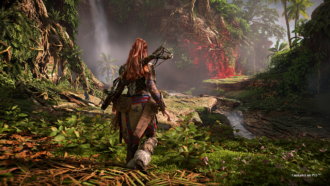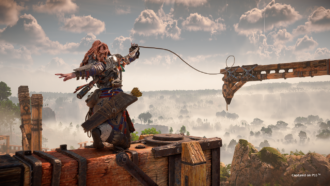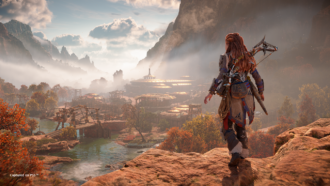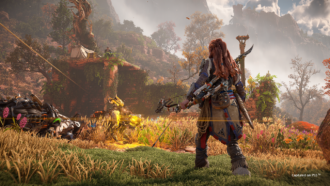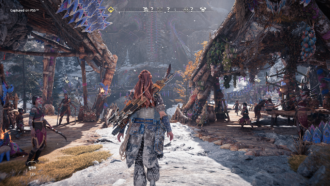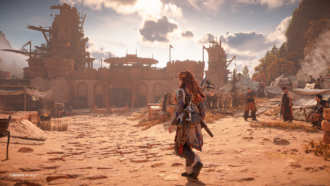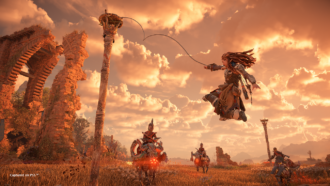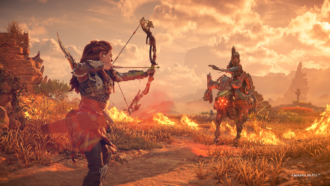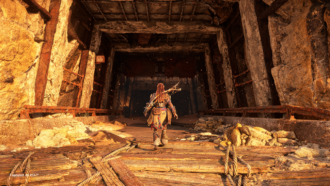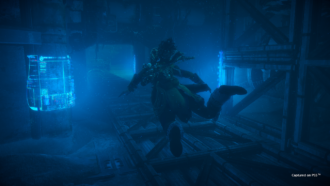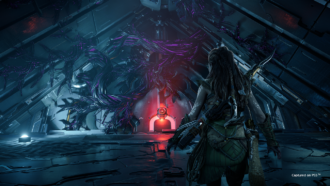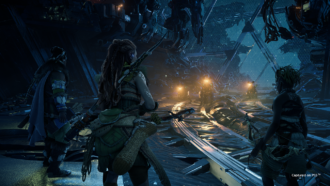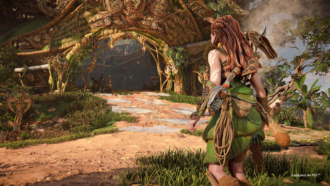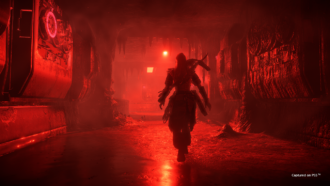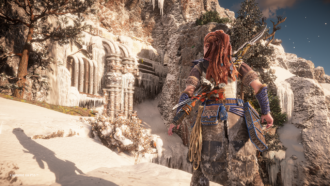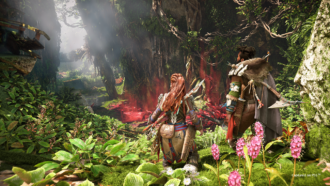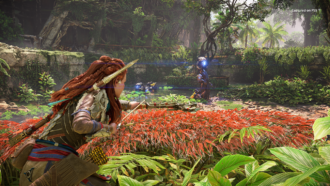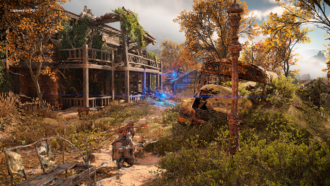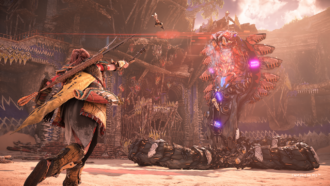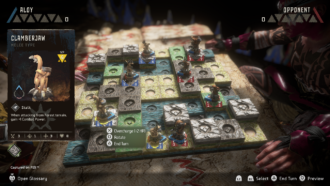Platforms:
PS4, PS5
Released:
February 18, 2022
Publisher:
Sony Interactive Entertainment
Developer:
Guerrilla Games
Horizon Forbidden West is the continuation of Aloy’s adventure, after taking our collective breath away with the stellar Horizon Zero Dawn back in 2017. Back then, we awarded it our Game of the Year, highlighting a world that was full of gorgeous detail, just begging to be explored. Five years later, the long-awaited sequel is not only a positive step forward for the series, but it’s also a sign that Guerilla Games truly listened to the feedback from the first game, enhancing and refining its systems in subtle but significant ways that make Horizon Forbidden West, quite simply, one of the best open-world video games I’ve ever played.
After the events in Zero Dawn, Aloy is a much more confident hero. Learning who she is and how she connects with the world was a large part of what made Zero Dawn’s story so intriguing and heartfelt. Still, while questions about her identity might be resolved, Forbidden West dives even deeper into the relationship between nature and machines, as Aloy looks to stop the blight that is ravaging the lands, killing wildlife, and leaving devastation in its wake. As life on earth hurtles towards extinction, it’s your job to brave the Forbidden West, unravel the mysteries of earth’s collapse, and try to save everybody – arguably a much bigger ask this time around.
Reputation is what people think of you, character is who you are
The legacy of Aloy and her victory in the last major battle has rippled throughout the lands, and her reputation often precedes her. No longer an unknown, when you interact with new characters, they are all aware of the prestige Aloy presents. This makes many conversations flow in your favour, and helping out the various people you’ll meet on your journey begins to make more sense; they know that Aloy can get the job done for them, so why not ask for help? However, with that notoriety comes extra pressure for Aloy, as she is still trying to figure out how to be the hero everyone makes her out to be.
As Aloy reunites with old friends and attempts to forge alliances with the various warring factions and the Tenakth warriors in the Forbidden West, she continues to be one of the most likable and rational heroes in all of video games. She’s emotional and caring when she needs to be, but tough and firm in her mission to save the world, at almost any cost. Fiercely loyal and often relatable, her plight is one that is once again a pleasure to experience, made all the more successful by the incredible voice talents of Ashly Burch who truly brings the badass female protagonist to life.
“…all of the voicework and characterisation is wonderful, with subtle animations in facial expressions adding weight to emotional scenes and fascinating conversations…”
Some other new major characters prove to be compelling in their own right, including the vicious Regalla voiced by the wonderfully talented Angela Bassett. She makes herself known relatively early as the main villain of the story, with a violent entrance that sets the tone for the rest of the adventure. A mysterious new character in Tilda is voiced by Carrie-Anne Moss, clearly showing her love for stories involving giant weird robots; she also stands out as a stellar performance. But really, all of the voicework and characterisation in Horizon Forbidden West is wonderful, with subtle animations in facial expressions adding weight to emotional scenes and fascinating conversations, making even the simplest side quest far more engrossing than it has any right to be.
The tests of the quests
While main story missions are lengthier and epic in nature and propel the story along, it’s commendable that side quests feel just as important due to their presentation. It reminds me of The Witcher 3, another RPG with strong side quests that stood alongside the core narrative. Side quests in Horizon Forbidden West all have meaningful stories, with characters I enjoyed talking to and genuinely wanted to help. Everything has a real purpose, and I found myself connecting more with the Forbidden West itself by nature of the people I was getting to know.
The range of quests all showcase the strengths of Horizon Forbidden West’s core gameplay elements, combining fun-as-heck traversal with varied, exciting combat, a dash of exploration, and investigative puzzle work. I was trying my best to focus on the main campaign so that I could finish the game as swiftly as possible but couldn’t help myself from getting distracted by side quests that sounded fun, interesting, or tantalizing in terms of the unlockable gear at the end of them.
Stories and characters in each situation add to the fascination; in one side quest, you’re helping a kid complete an ancient trial by climbing a mountain, defeating enemies along the way. Another has you supporting a village by helping them defend against the machine threat. Then there’s harvesting machine parts to help a clan in trading for resources or finding evidence of a jailed soldier’s innocence. The companions you’ll meet along the way also each have their own important personal quests. It’s a testament to their quality that, despite my best efforts, I couldn’t help myself but to want to help everyone, as the pay-off – narratively and in terms of gear and skill points – was always worth it.
Movin’ on up
Of course, all of the missions in Horizon Forbidden West live and die by the gameplay, and systems have been refined to make mechanics as smooth as possible. First, traversal in general is incredibly satisfying; I can’t recall many times in gaming where I saw a giant cliff face in front of me and thought “awesome, I can’t wait to climb that”, but here it’s always a treat. By simply activating your focus, all of the handholds and ledges are instantly highlighted in front of you, so you know exactly what is climbable and what isn’t. It saves finicky climbing where you end up going the wrong way or, attempting to jump at a wall that looks climbable… but isn’t.
In fact, traversal in general has been made incredibly accessible across the board. Climbing feels great, and the added tool of the “Pullcaster” allows you to quickly double jump, grappling and pulling yourself towards specific high points. This is useful not only in covering more ground quickly when climbing, but also in terms of navigating platforming puzzles or quickly escaping a dicey situation in combat. You’ll also relatively early-on acquire the “Shieldwing”, so you can leap from a tall point and sail down, which feels amazing as you soar across the map from a mountaintop.
There’s also Campfires littered all over the map which act as free fast-travel points between one another, and of course, machine monsters that can be overridden and used as mounts if you prefer to explore. It just feels good getting around the place, which is handy when there’s so much to do in Forbidden West. Additional equipment that you gain as you progress through the campaign will allow you to access areas on the map previously inaccessible, including an explosive charge in your spear to ignite “fire gleam” to create new paths, and eventually a diving mask that allows you to stay underwater permanently.
Don’t go breaking my components
Combat is a core strand of Horizon’s DNA, and it’s just another element of Forbidden West that has been further refined from its predecessor. The standard light and strong attacks are helpful against smaller machines, with a strong attack triggering a knockdown that can lead to a critical strike on an enemy, but it’s the choreographed dance between melee combat and the various tools at your disposal that make battles sing. After enough strong melee attacks, for example, you’ll open up a special temporary targeted attack area which must be shot with a projectile, that can turn the tide of battles quickly.
There are a range of different bows that vary in their strengths and weaknesses, with different arrow types available for each; for example, some machines are particularly vulnerable against acid attacks, which forces them to corrode and take damage consistently while you wail on them from a distance with explosives. Using your focus to highlight an enemy’s weakness is especially handy, and this time around you don’t need to literally zoom in on each body part – just a quick press left or right cycles between them, which is a godsend and another smart tweak to refine the system from Zero Dawn.
“Thinking on your feet, adapting, and becoming a master of all the weapons and tools available to you feels excellent and inspires a lot of creativity.”
While you can use your standard arrows and attacks to cause damage, it’s understanding each machine that adds a layer of tactics to each fight. Components will need to be targeted so you can lop them off to gain them for upgrades or quests, and certain cannister types need to be matched with different weapon types to cause maximum damage. Other weapons make for some creative thinking, such as a variety of traps that can be placed, flinging dangerous flying discs that cut through foes or, my favourite, a javelin that explodes, great for targeting specific weak spots. Thinking on your feet, adapting, and becoming a master of all the weapons and tools available to you feels excellent and inspires a lot of creativity.
There’s a large range of machine types, new and old, to be fought and overridden, too. The Tremortusk (which you may recognise from trailers) is a mammoth-like creature with large tusks and a flamethrower in its trunk. Sunwings are a new flying type that patrol the skies, while Burrowers can, as the name suggests, burrow underground, while also alerting other machines in the area. There are even some underwater machine variants to be aware of too, like the crocodile-esque Snapmaws. Human enemies aren’t to be scoffed at either, especially those with access to high-damage automatic weapons. When combined with the array of machine types seen previously in Zero Dawn, there really is a new tactic required for each, which keeps things dynamic and fresh when exploring the vast, dangerous world.
What’s that over there?
There are settlements you’ll come across, and eventually a home base that you can always return to which evolves in interesting ways as you progress through the story. These encampments are filled with various merchants so you can purchase more gear, a handy workbench so that you can upgrade your existing weapons and armour using the resources and machine parts you’ve collected throughout the world, along with finding side quests or simply rumours from the locals about nearby points of interest. These settlements are bustling with NPC’s going about their day, making the world feel truly lived in as you explore.
In terms of other distractions, there sure are plenty. My favourite has to be the Relic Ruins, reminiscent of the Challenge Tombs in Tomb Raider, but on a smaller scale. Solving these platforming puzzles (that usually amount to moving crates, finding codes, and navigating a small-but-tricky environment) were a lovely brain-teasing distraction from the more intense missions, and I truly loved seeking them all out. Tallneck’s are back, too, those giant creatures that act as a radar to reveal more of the gigantic map; these big lads serve as puzzles themselves, as each one has a unique way of climbing to the top that must be solved.
Cauldrons take you to a more technology-driven environment, almost like the inside of a spaceship, where you must combine all of the tricks in your book to find your way through and survive the challenging fight at the end of each. Completing these allows you to override more machine types, giving you more mount options or having them fight on your side, particularly handy against multiple foes.
There are Salvage Contracts, where you have to collect certain machine parts, in one instance by setting up an ambush for a machine convoy. Hunting Grounds and Melee Pits are scattered around so that you can test out your fighting skills against man and machine, plus you can clear out Rebel Camps and Outposts, Far Cry style, for additional rewards. There are also machine races that act as Forbidden West’s dangerous and deadly version of Mario Kart, plus other collectables like survey drones to find, jump to, and pull to the ground, and Vista Points that require you to overlay an old image with the environment surrounding you to match it up. There’s even a board game called Machine Strike where you can compete against others and collect pieces for it on your journey; it’s fun to play in and of itself, just the right amount of challenge in each battle.
If I haven’t made it clear with the above, there’s a lot to do in Horizon Forbidden West, and it’s feasible that you could spend a hundred hours or more if you were to try and complete everything on the map. I finished the main campaign after doing a bunch of side quests and dabbling in most distractions in about 30 hours, but I know there’s a lot more to do with my map full of markers to cross off. It doesn’t suffer from bloat in the same way other open-world games have in the past; everything you do in this game has meaning, a motivation for completing it, whether it’s tied to the lore or to some tangible reward that helps make you stronger in some way.
Subtle improvements, big difference
While Zero Dawn was visually impressive back in 2017 (and its PS5 upgrade even better), Forbidden West is simply stunning, always. I’ve already spoken about the animations of characters themselves, but the world simply feels alive, with little visual details everywhere and impressive draw distances that allow you to stand on a mountain and look right across the map.
Horizon has always been a strong contrast between the natural world and the machine world, and that difference translates into a gorgeous landscape of lush forests, red deserts, snowy mountains, and glistening bodies of water, right next to strange metallic shapes, glowing spaceship-like interiors, and cold, blue, electronic-filled laboratories. This vivid and dramatic difference is highlighted further in specific memorable settings, like gorgeous underwater caves that are filled with glowing mushrooms protruding from long lost structures and buildings, or ruins falling apart after being destroyed by time and blight.
I was concerned that Horizon Forbidden West might compromise on its visual quality due to being available on PS4 as well, but that definitely doesn’t feel like the case. Photo mode lovers have some good times ahead of them. Beyond all of that, it’s the little things that elevate the experience. As I said earlier, climbing spots are highlighted with the focus. Enemy parts can be quickly scanned with a button press. Extra resources that you can’t carry get automatically sent to a stash, and then are easily topped up with the press of a button when you need them. Everything is laid out so that you know exactly where you need to go and what you need to do, even when it’s just finding the right pieces to upgrade your gear. It doesn’t hold your hand, but it respects your time, and in an open-world game with so much content, that’s a feat worth celebrating on top of everything else.
10
Masterpiece
Positive:
- Compelling narrative with genuinely interesting side quests
- Characters are great, with strong voice acting and good storytelling
- Traversal feels amazing, with many ways to navigate the environment
- Combat allows for creativity and is always exciting
- Every side activity has meaning and is enjoyable, with heaps to do
Negative:
- Another large open world with heaps to do can be daunting
Horizon Forbidden West is everything you could hope for in a sequel. Not only does it provide more content to sink your teeth into, but it makes smart design decisions that refine its systems to be near faultless. Aloy’s personal story continues to evolve, this time with an even stronger supporting cast and memorable antagonists propelling her journey to another level. Above all, its moment-to-moment gameplay expertly combines the fun traversal, exciting combat, and creative problem-solving to awesome effect, meaning it always feels excellent to play. Horizon Forbidden West is one of the best open-world adventures available today and is a stellar experience from its strong introduction all the way to its dramatic conclusion, and beyond.

